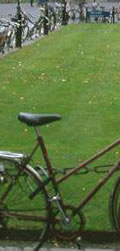
Zero Waste is the Goal
on UNC Campus
Cindy Pollock Shea
Sustainability Coordinator UNC Chapel Hill
Last modified: October 31, 2002
| GRRN's 'Campus Zero Waste' Project
contains links and descriptions originally compiled by
Roger Guttentag, who writes the Recycling in Cyberspace Column for the monthly periodical Resource Recycling. |
| Many
companies and institutions now realize that anything leaving
the premises via a dumpster, discharge, or smokestack is an
unnecessary expense and potential liability. The new thinking
is that everything leaving the building should generate
revenue. A DuPnt representative speaking recently at UNC’s
Kenan-Flagler Business School, stated that new DuPont
factories in Asia have almost reached the corporate goal of
zero waste and emissions.
At UNC Chapel Hill, a similar effort is afoot to reduce waste campus-wide. The traditional recycling program for paper products and beverage containers, coupled with composting of food waste from the main dining hall and research laboratory animal bedding captures 37 percent of campus discards. This saves $600,000 annually in avoided landfill fees. Adding the 16,000 tons of recycled coal ash from UNC’s combined heat and power plant to the waste equation, brings the overall campus recycling rate to 74 percent. A new program that was piloted in August at Fall Fest will reduce the waste generated at special events by providing staffed recycling stations that include a container for compostable food waste and paper products. Today’s concept of waste encompasses an ever larger scope. Warm air leaving a building on a cold day represents an energy source that could be used more efficiently. Rainwater is a valuable resource that could be used to flush toilets or irrigate the landscape. Fluorescent lights illuminated on a sunny day represent both electricity consumption, and an increase in air conditioning load, that would be unnecessary if the building were designed to harness daylight more effectively. New programs to use energy, water, and materials more efficiently are being introduced in a range of new and existing campus buildings. With 5.9 million square feet of new buildings and renovations planned over the next 10 years, campus construction waste could overwhelm area landfills and quickly run up disposal costs. At the Murphey Hall renovation project begun last year, a waste management specification was included in construction documents for the first time. Campus departments, outside architects, and stores that sell second-hand building materials first identified items that could be salvaged and used again. Once the contractor started work, these items were released to the parties that had expressed interest in them. Then the contractors wrote up plans for managing and recycling the items they would remove from the building. Limited space prevented a separate container for each material type. Fortunately, Materials Reclamation in Raleigh separates mixed loads of building debris for recycling. Fully 85 percent of the materials removed from the building found a new life as a recycled product. The contractors saved money relative to disposal and readily admitted they would not have explored the recycling option if the University had not pushed it. The Campus Master Plan to guide the placement of new buildings, parking, and greenspace includes an Environmental Master Plan to guide natural resource management. One tenet of the plan is that stormwater be regarded as an opportunity, rather than a problem. While most new buildings and parking lots create more impervious surface, which increases stormwater runoff, UNC Chapel Hill has adopted a different approach. In the future, stormwater will be used to irrigate new and existing green spaces and slowly recharge creeks. During the expansion planned throughout this decade, the University has pledged not to increase the volume, rate or pollutant load of stormwater leaving campus. Infill development, clay soils, and a vast network of underground utilities rule out the use of detention ponds, the strategy most area developers use to hold runoff. Instead, the University is exploring a range of best management practices and has already adopted several. The new Park and Ride lot on Highway 54, next to the Friday Center, is topped with porous pavement, as is the expansion to the remote student parking lot on Estes Drive Extension. Porous pavement -- and the gravel underneath it -- store rain until the water seeps slowly into the ground, recharging area creeks. The petrochemicals and heavy metals that typically flush quickly into storm sewers and streams are filtered by the soil, rendering them less harmful to ecosystems. Recreation fields and new green spaces provide additional water holding potential. At Carmichael Field on South Road a 70,000 gallon underground cistern stores the rain that falls on the School of Government and the indoor track. The water will be used in the future to irrigate the playing field. (This site is not yet sodded because of outdoor watering restrictions.) At the Carrington Nursing School addition, a vegetated roof -- known in the ecological building world as a “green roof” -- will soak up rainwater. Situated next to an attractive patio, the privately funded roof will provide students with a green vista during breaks in their studies. In some German cities, the multiple benefits of “green” roofs make them mandatory in new construction. A green roof is also planned at the Rams Head Project. There, a surface parking lot will be transformed into a three level parking deck. Atop the deck will be a green plaza, an at-grade walkway in a currently steep part of campus, and a new dining hall and recreation center. Rain falling on the buildings will supply water to irrigate the plaza, providing a new green gathering place on south campus. Lighting upgrades, water-free urinals, and recycling programs for batteries, dental amalgam, and computer monitors are all part of the effort to reduce waste at UNC Chapel Hill. As national recycling activist Gary Liss puts it, “If you’re not for zero waste, how much waste are you for?”
|
